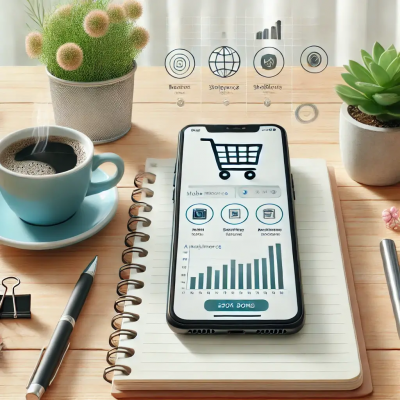Blog /
Mobile Marketing for E-commerce

With the gradual shift of consumers towards shopping on mobile devices, mobile marketing has become a major influencer in e-commerce. M-commerce is likely to contribute more in the share of total online sales in the near future. As one recent study estimated, in 2021, mobile commerce is expected to compose almost 73% of total e-commerce sales. A fact that underlines the increasing need and importance of optimizing your online store for mobile users to be competitive.
The rise in mobile commerce itself creates an ever-increasingly important requirement for the proper understanding of mobile marketing to those seeking to expand reach and conversion for businesses. A properly run mobile marketing campaign-using either websites, apps, or targeted ads-will reward investments not just with better sales figures but also through improving customer experiences.
Mobile Marketing in E-Commerce
This explosion of mobile commerce marks an essential turning of tides in consumer retail behavior: instead of relying on a desktop, most of today’s people surf products, price compare, and actually buy via smartphones. In that way, this changes things for the company’s approach-it can no longer opt out of but will need a high-performance mobile marketing strategy just to keep pace and please.
Mobile marketing allows e-commerce companies to reach their potential customers at any time and from any place in real time. Since most online shopping is done today on mobile, a seamless and optimized mobile experience can make all the difference between a sale and a cart abandonment. Furthermore, it will help tap into the growing trend of on-the-go shopping, making the user browse through and buy the product whenever it’s most convenient.
Mobile Commerce Growth Trends
M-commerce has grown steadily for several years and shows no signs of slowing. This may partially be due to a global increase in smartphone adoption. In 2021, mobile accounted for 54% of all website traffic and a higher percentage of online sales were mobile transactions.
It has opened up several business opportunities, ranging from developing mobile-compatible websites and applications to running target advertisements. And these users aren’t just browsing; they’re buying, making the mobile experience the key to their success. By the year 2022, m-commerce is believed to be catching up with desktop e-commerce, and in subsequent years, this share of only mobile purchases would continue to grow.
What Is Mobile Marketing for E-Commerce?
e-Commerce mobile marketing strategies and methods may be used by online businesses to reach and engage customers through mobile devices. It would involve creating a mobile version of the website, a mobile application, push messages, and social media ads targeting users through smartphones or tablets. Since the number of purchases using mobile is growing, every business has to shift toward a mobile-first approach in order not to have interruptions while creating an experience for mobile users.
It also requires knowledge of the special behavior and preferences that characterize mobile shoppers, optimization of content for small screens, speed, and use of mobile-friendly payment options. Besides, driving conversions and loyalty can be achieved by using mobile-specific features like GPS, location-based marketing, and personal notifications.
Key Components
At its core, mobile marketing for e-commerce aims to create a seamless and engaging shopping experience for mobile users. Key components include:
- Mobile-Friendly Websites: Ensuring your website is responsive and loads quickly on mobile devices.
- Mobile Apps: Offering a dedicated app can enhance user experience and provide a platform for exclusive offers and personalized content.
- Push Notifications: Sending timely, relevant notifications to users to re-engage them and encourage purchases.
- SMS Marketing: Leveraging text messages for promotions, order updates, and time-sensitive offers.
By incorporating these components into your strategy, you can ensure that your e-commerce site is fully optimized for mobile users and increase the chances of conversion.
Mobile Devices in Online Shopping
Mobile devices revolutionized the way people shop. It has evolved from a mere browsing device to an essential gadget for completing a transaction, managing orders, and getting customer support. Today, consumers expect frictionless, seamless shopping across all devices, especially mobile.
From instant product queries to one-click payments, mobile devices facilitate the ability for people to shop at any time and any place. Flexibility like that shifts shopping habits, and they need to make sure they are fitted to mobile-first customers. For this, no doubt, from browsing on product listings through reading reviews or making purchases in fact, every single part is integral to end-to-end mobile-driven shopping.
Why Mobile-First Strategies Matter
Now, a mobile-first approach is no more a nicety; it’s a necessity for businesses. Mobile-first means that literally every single aspect of your marketing and website design should be focused on users who are probably accessing it on their mobiles. As more and more consumers are shopping through smartphones and tablets, such businesses that will not offer a mobile-first experience are visibly losing market share.
In the mobile-first approach, you get a fully mobile-optimized website or app for customers. The outcome is a seamlessly great experience for customers that keeps them engaged. It includes everything from faster loading to better navigation, and most user-friendly interface that amplifies the conversion rate by manifold times with customer satisfaction.
Key Strategies for Mobile Marketing in E-Commerce
To make the most of mobile marketing, e-commerce businesses need to implement key strategies that cater to the needs of mobile users. Here are some essential tactics to consider:
- Mobile-Friendly Website Design: Make sure your website is responsive, easy to navigate, and optimized for mobile users. This includes minimizing pop-ups and ensuring that all buttons are large enough to tap easily.
- Mobile SEO Best Practices: Optimize for mobile search by focusing on voice search and local SEO. This helps ensure your site ranks well in mobile search results, which is crucial for attracting mobile shoppers.
- Push Notifications: Use push notifications to engage users with time-sensitive offers, product recommendations, and reminders about abandoned carts. Tailoring notifications based on customer behavior increases their relevance.
- Mobile Apps: Offer a mobile app for a more personalized experience. Apps can provide quicker access to your store, easy checkout options, and exclusive deals, all of which can drive customer loyalty and sales.
Mobile-Friendly Website Design
As more and more people shop through their smartphones, making your ecommerce website mobile-friendly is no longer an option; rather, it has become a dire necessity. A mobile-friendly website automatically resizes to all screen sizes, offering a seamless interactive user experience. If your site doesn’t look or function great on mobile devices, you will lose potential customers.
Responsive Design Principles
Responsive design ensures that your website will look great and work just fine on desktops, tablets, and smartphones alike. It adjusts automatically to the various screen sizes with no need for end-users to zoom in or scroll horizontally. This will mean that for an e-commerce store, the images, descriptions, and buttons are of appropriate size and easy to use on smaller screens.
A responsive design also contributes to search engine optimization, as search engines give preference to mobile-friendly websites. With Google’s mobile-first indexing, the mobile version of your site will be considered the primary version while ranking it. So, investing in responsive design isn’t just a user experience improvement; it boosts your SEO, too.
Page Speed Optimization for Mobile
Mobile visitors would not wait long for the loading of websites. Indeed, research has shown that 53% of mobile visitors leave sites which take over three seconds to load. Poor load times make the users irate, besides increasing the rate of bounces, so optimization considering speed is paramount for a website.
Other principles to make your mobile website faster: compress images without sacrificing quality, use as few heavy scripts as possible, and enable browser caching. Tools like Google PageSpeed Insights will point out where improvements are to be made so that your site loads fast enough for users not to get bored waiting.
Mobile SEO Best Practices
Mobile SEO is very important in ensuring that your e-commerce store features well in the search engines whenever mobile users are searching for any product or service. By optimizing your website for mobile search, you show up higher and increase the chances of driving traffic to your store.
Optimizing for Voice Search
As most voice searches happen on mobile and are on the rise, lots of people rely on Siri, Google Assistant, Alexa, and other tools to find what they need. Ensure your optimization strategy considers voice search; these tend to be much more conversational. Instead of targeting just the keywords “running shoes,” optimize for “where can I buy running shoes near me?”
You can also appear in these voice searches through schema markup on your website that answers common questions, such as “What is the best pair of running shoes for beginners?.
Local SEO for Mobile Users
Actually, the majority of mobile users perform location-based searches. Therefore, it is worth mentioning that your website should include local SEO to take full advantage of the location-based search like “best coffee shop near me” or “buy shoes in the city of.”. Also, update your Google My Business listing and sprinkle keywords related to your location throughout your site.
This is particularly so for e-commerce businesses that have physical locations. When mobile users search for products in their vicinity, they are most likely to select businesses that turn up in the local search results, including Google Maps and localized search queries. Optimizing your content with geographic keywords, meta tags, and business listings will go a long way in helping your visibility to local searches.
Mobile Apps for E-Commerce Stores
Certainly, having a mobile application for every e-commerce store will really help in customer engagements and retention. Apps are seamless, personalized; that is where your customers can navigate around and purchase something or just receive push notifications concerning upcoming sales or promotions.
Benefits of Having a Dedicated App
The mobile app is going to help e-commerce stores in several ways. First, apps load and navigate faster than websites. With the application, you will be able to have closer relations with your customers since you will offer them recommendations regarding their earlier preferences when browsing or buying products.
This would also ensure more brand loyalty because an app can directly offer loyalty programs, discounts, and other promotions to the users. They also make transaction management, tracking of orders, and customer support much easier, hence enhancing the overall shopping experience.
App Marketing Strategies
Promoting your app is so necessary to reach a wide audience. Give incentives to first-time users, such as discounts or free shipping upon downloading of your app. Provide push notifications, social media campaigns, and email marketing campaigns for downloading the app. Listing the application with optimization in the App Store and Google Play, together with good keyword usage, improves visibility and downloads.
App marketing can also be integrated with other mobile marketing activities, such as retargeting ads and email campaigns, to make the experience even smoother and more cohesive for your users. The better integrated your app is with your general marketing, the more effective it will be at retaining and engaging customers.

Leveraging Push Notifications
Push notifications ensure nowadays that your e-commerce store remains in the minds of users. These notifications simply pop up at the mobile screens of users and persuade them to finally complete a purchase, check some new product, or to use the coupon code.
Personalization for Better Engagement
These push notifications can be personalized so they would bring much better results since they would include something of value for a user. This may involve sending a restocked notification, promotion, etc., according to the previous shopping habits of a user. It is in this regard that personalization could increase click-through rates to make purchases.
Best Practices for Timing and Frequency
Timing and frequency mean everything in push notifications. Send at times when the users are likely to be more receptive, for example, after work hours or on weekends. So, avoid bombarding them with notifications, because it could result in app uninstalls. Conversely, space them out, and focus on delivering high-quality relevant messages adding value to the user’s experience.
Simplified Navigation and Search Functionality
Navigation on mobile can either make or break the e-commerce experience. Mobile users need to find what they want quickly and easily. If your website navigation is too complex or cluttered, users will bounce, and sales opportunities will be lost.
Keep it Simple and Intuitive
On mobile, simplicity is key-it’s a small amount of screen space. Go for a clean, minimalistic web design where products are easy to find. Prioritize links that are important, like categories, a search bar, and your cart. Ensure the menu of your site is easily accessible, with clearly defined categories which make sense to your users. A good rule of thumb is to decrease the amount of taps from the homepage to a product.
Optimize the Search Function
This would mean a responsive and quick search on mobile. It is a real drag having to trawl through pages on a mobile, so robust search that actually delivers accurate results is important. Adding filters and auto-suggestions based on best-selling or most recently searched products makes this process much smoother and quicker.
Secure Mobile Checkout
What will drive mobile e-commerce through to success is a safe and smooth checkout. The customer must feel that his personal and payment information is secure, while he also needs a seamless process to reduce friction and prevent cart abandonment.
Simplify the Checkout Process
Mobile shoppers are searching for a quick and seamless checkout. The fewer steps, the better. Guest checkouts allow avoiding the discouragement of users by not having to create accounts; hence, this simplifies and can be on one-page checkout that considerably raises the rate of conversions. Make every step clear, intuitive, and not confusing to the user.
Security is Key
Mobile users are more sensitive when it comes to sharing their payment details online. Ensure your e-commerce store is HTTPS-enabled and has security badges to give confidence to customers that their data is secure. This will help further enhance security and boost conversions by offering trusted payment options like PayPal, Apple Pay, or Google Pay.
Analytics and Performance Tracking
To enhance your mobile marketing, you have to know how users interact with your site to understand where improvements can be made. Analytics provide the data required for understanding customer behavior and making effective decisions.
Metrics to Measure Mobile Marketing Success
The right metrics tracked will enable you to assess the effectiveness of your mobile marketing strategies. In addition, this will help you understand how well the site is performing with such metrics as conversion rate, AOV, and bounce rate. Tracking these regularly enables you to find where users are dropping off and where they are most engaging.
- Conversion Rates: The ultimate goal is to turn visitors into paying customers. Keep a close eye on your conversion rates to see how many visitors are making purchases.
- Bounce Rates: A high bounce rate suggests that visitors aren’t sticking around long enough to engage with your content. It’s important to investigate why they’re leaving and address any issues that may be causing this.
- Engagement: Track how long users spend on your site and how many pages they visit. Low engagement may indicate poor user experience or slow load times.
Tools for Mobile Performance Analysis
Of course, there are many tools out there that will help you in finding your site’s mobile performance. For instance, Google Analytics has a lot to offer in tracking mobile-specific data like mobile traffic, bounce rate, and conversion rate. Other tools such as Hotjar and Crazy Egg go a step further to include heat maps on where users are clicking and how they’re interacting with your mobile site.
Using these insights, you can continuously refine your mobile marketing strategy to optimize for better user engagement and higher conversions.
Future Trends in Mobile Marketing for E-commerce
As mobile technology evolves, so do the strategies for engaging users. Staying ahead of trends is essential to remain competitive in the ever-changing mobile marketing landscape.
5G and its Impact on Mobile Commerce
5G is going to give a whole new meaning to shopping on the mobile device. With higher access to quicker internet, users will browse and shop easily on mobile. Product browsing will go smoother, there will be less time wasted for loading, and the capability of giving richer multimedia experiences like high-quality videos or AR features will be possible. This means that e-commerce stores will have to optimize their websites to handle the increase in traffic and make full use of the increased speeds.
AI and Personalization in Mobile Marketing
Artificial intelligence renovates mobile marketing to a more personalized shopping experience. E-commerce brands can analyze consumer behavior and personalize product recommendations with the use of AI. AI-powered chatbots improve customer service by responding instantly to queries, navigating users through the shopping process. Personalization at scale is going to be the future, and businesses that wield AI to improve user experience will thrive in this competitive edge.




